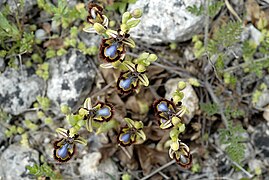Parco dell'Etna
The Parco dell'Etna (German Park of Etna ) is an Italian regional park around the Etna volcano in Sicily . It was established in 1987 in order to protect the unique flora and fauna of the landscape around the volcano from arbitrary economic and tourist development and to be able to centrally control the use of the territory.
The Parco dell'Etna covers the area of the following municipalities, among which the mountain is divided into pieces of cake: Adrano , Belpasso , Biancavilla , Bronte , Castiglione di Sicilia , Giarre , Linguaglossa , Maletto , Mascali , Milo , Nicolosi , Pedara , Piedimonte Etneo , Ragalna , Randazzo , Sant'Alfio , Santa Maria di Licodia , Trecastagni , Viagrande andZafferana Etnea .
history
The area around Mount Etna, which is characterized by lava stone and therefore extremely fertile, has always had an animal and plant world that can hardly be compared and is unique in Europe in this form. But the rapid development of the area with paved roads and by means of deforestation and the unrestricted hunting in this area raised great concerns about the continued existence of this habitat.
In the 1960s, a group of ambitious students and conservationists around Professor Valerio Giacomini was the first to call for a regional park to be set up in the area. But it was only after arduous, particularly political, disputes that the regional parliament passed Law No. 98 ( Legge n. 98 ), which regulated the establishment of three regional parks ( Parco dei Nebrodi , Parco delle Madonie and Parco dell'Etna).
Between 1982 and 1985 a commission made up of representatives from the 20 affected communities, nature conservationists and professors tried to come up with a concept for the establishment of the Parco dell'Etna, but their work was largely fruitless. The park was only officially established in March 1987 and in August of the same year an institute for the central administration of the park was established in Nicolosi ( CT ) ( Ente del Parco dell'Etna ). Since then, the ecological and economic development of the area has been monitored from here and the sustainable development of the habitat has been ensured.
Zones A to D
The Parco dell'Etna has a total area of almost 59,000 hectares and is divided into four zones from A to D. In the central zone A, which covers a circle of 19,237 hectares around the summit of Mount Etna, nature is in its original state and is largely untouched. In the ring of zone B (25,391 ha) surrounding zone A, traditional cultivation and development take place, while in the lower rings of zone C (4188 ha, so-called pre-parco ) and zone D (9551 ha) only a nature-friendly and sustainability-preserving use is prescribed.
Flora and fauna
Several vegetation zones can be distinguished on the mountain slopes . Fields and plantings predominate up to about 800 m slm . Wheat, citrus fruits, olives, figs and grapes thrive here. This zone is followed by large forest areas with oaks, chestnuts, beeches, pines and, in higher regions, also pines. From around 2000 m slm the vegetation changes into scrub and shrubs such as the Etna gorse . This is followed by a zone with lichens and mosses, the highest regions around the summit are without vegetation and mostly snow-covered.
The chestnut tree of a hundred horses stands on the eastern slope of Mount Etna . It is widely regarded as the largest and oldest tree in Europe.
The animals living in the regional park include wolves, foxes, martens, porcupines, red deer, dormice, wild rabbits and hares. The bird world is particularly diverse with around 70 different bird species . In addition to numerous songbirds, woodpeckers and birds of prey such as golden eagles and peregrine falcons can be observed.
Young red fox
Spiegel-Ragwurz on the southern slope of Etna
Black pine on Etna
Large mouse- eared mouse in the Grotta tre Livelli
See also
Web links
- Parco dell'Etna website (Italian, English)
- Parco dell'Etna in the portal of the Italian national and regional parks (Italian, English)
Coordinates: 37 ° 45 ′ 55 ″ N , 15 ° 0 ′ 0 ″ E







